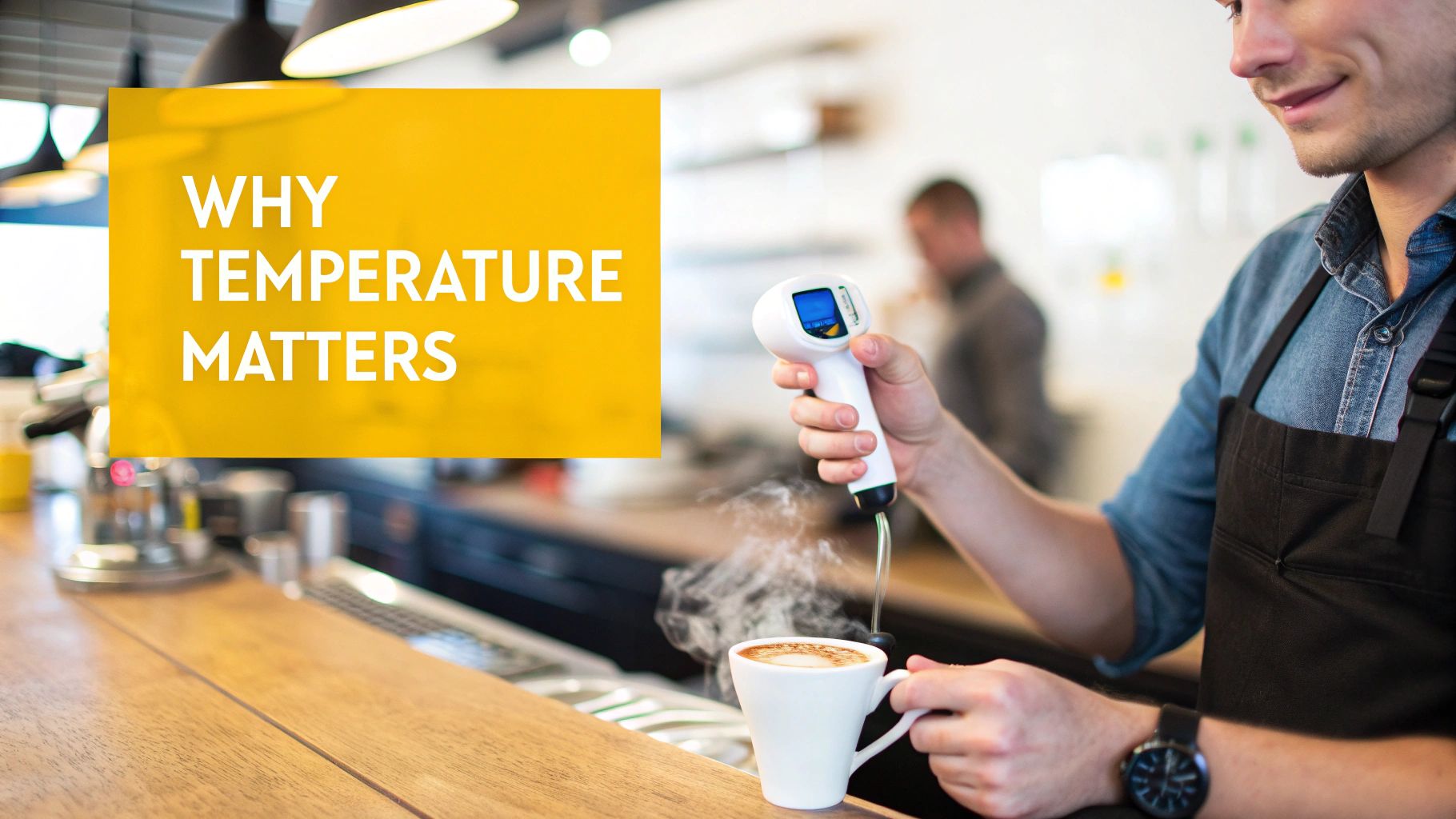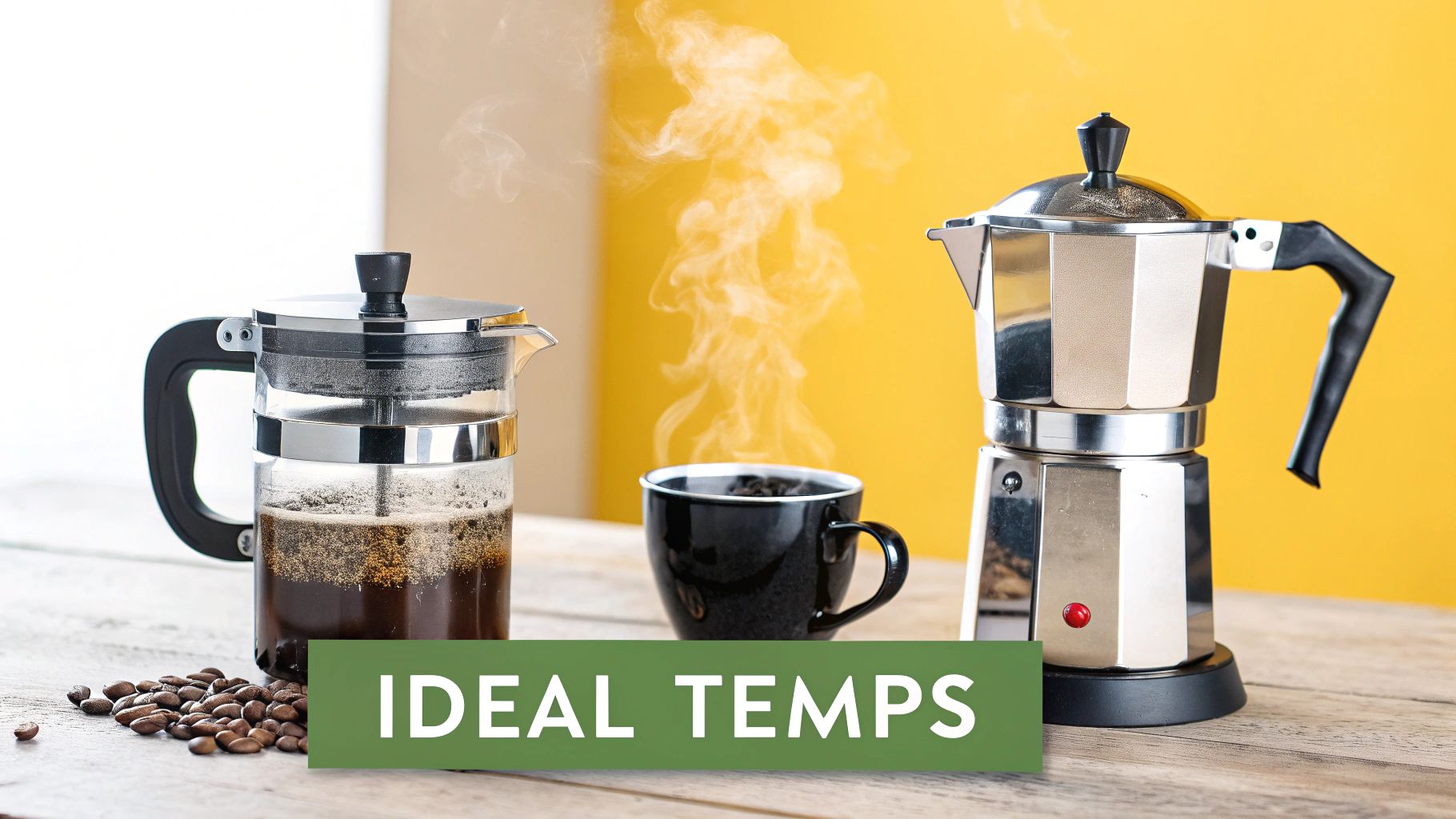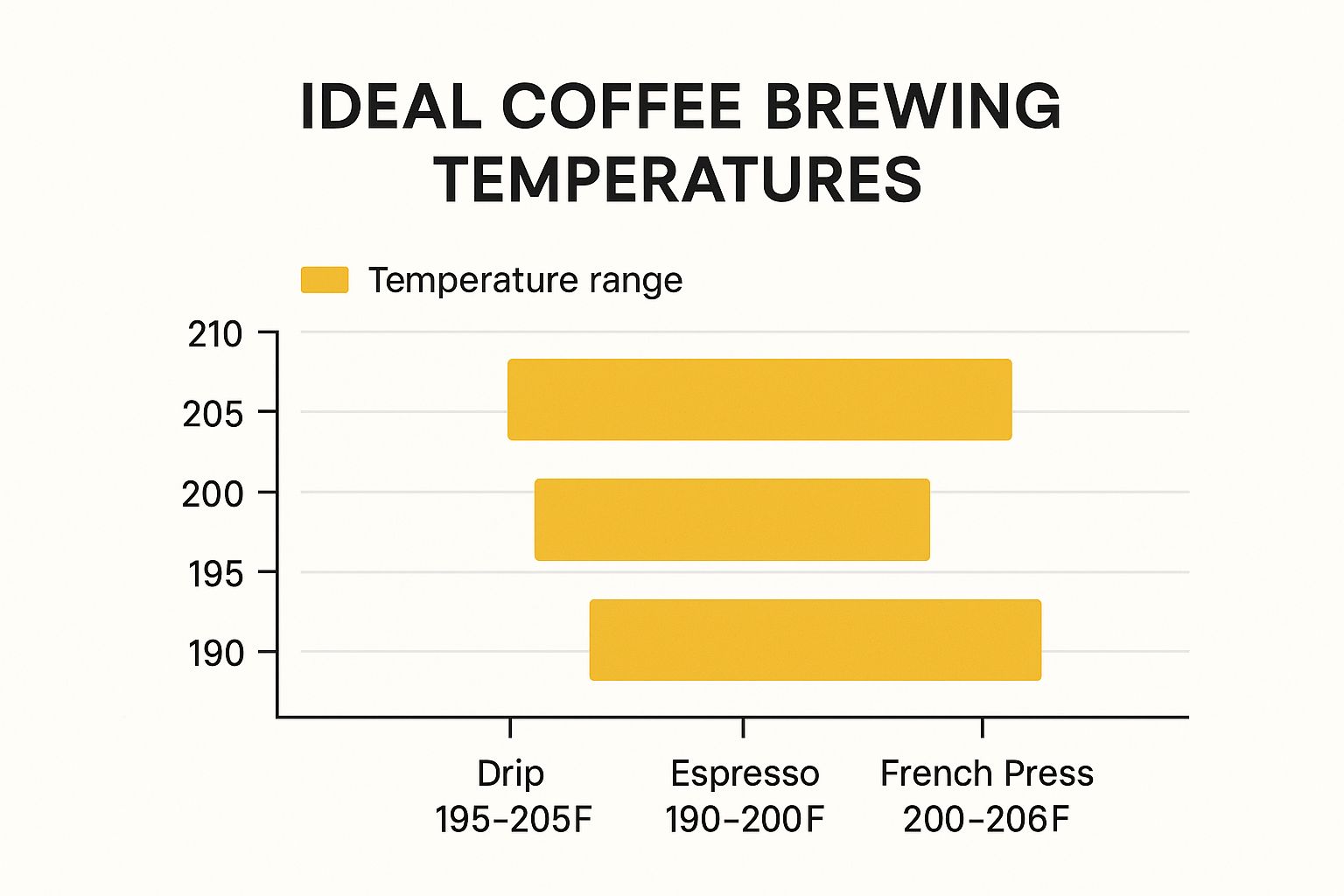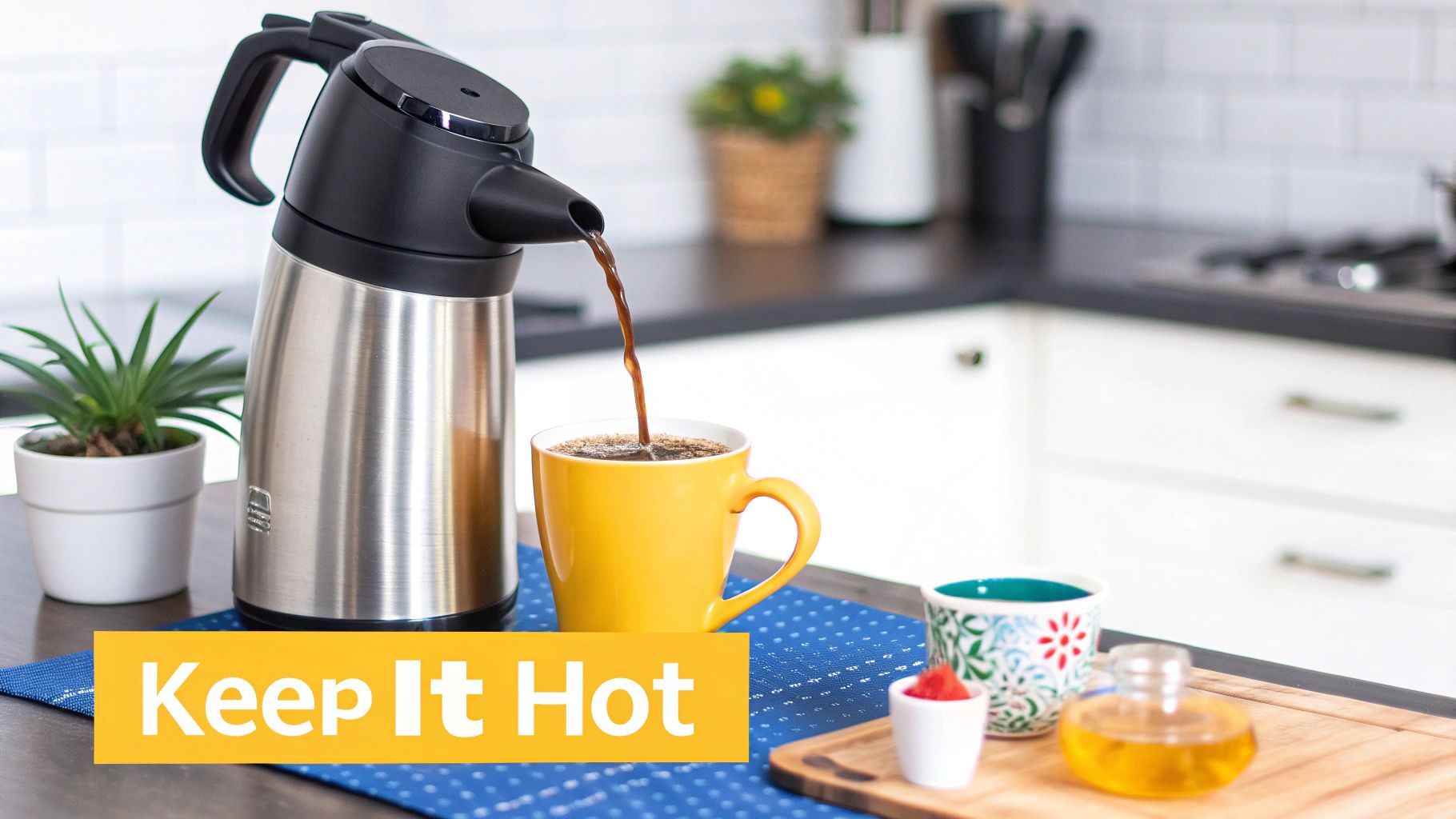Have you ever made a cup of coffee that tasted absolutely perfect one day, only to have the next day's cup fall completely flat? The secret culprit is often hiding in plain sight: your water temperature.
The truth is, the correct temperature for coffee isn’t a single number. It’s two. There’s one temperature for brewing and a completely different one for drinking. Think of it like a perfectly baked loaf of bread—it needs a hot oven to rise and cook through, but you have to let it cool down before you can actually taste and enjoy all those amazing flavors.
Why Coffee Temperature Changes Everything
Water is the engine of extraction in coffee brewing. Its temperature is what coaxes out all the good stuff from the grounds—the sugars, oils, and delicate acids that make up the flavor profile. It's a real balancing act.
If your water is too hot, it will over-extract and scorch the coffee, leaving you with a harsh, bitter taste. But if the water is too cool, it won't pull out enough flavor, resulting in a cup that tastes weak, sour, and underdeveloped. It’s a classic Goldilocks situation.
Getting that brewing temperature just right is the first step, but the journey to a great cup doesn't stop there. The temperature you drink your coffee at is just as important for appreciating its nuances.
Brewing Hot vs. Drinking Warm
This is where most people miss a huge opportunity to level up their coffee game. You need high heat to unlock all the complex flavors locked inside the coffee, but you need a cooler temperature to actually be able to taste them.
Sipping coffee that's scalding hot does more than just burn your tongue; it completely numbs your taste buds. This masks all the subtle sweetness, bright acidity, and unique notes that make a specific coffee special.
It’s as the coffee begins to cool that its true personality starts to shine through. This isn’t just opinion; it's backed by science. Research from the University of California Davis confirmed that while coffee needs to be brewed hot, people enjoy it most when it cools to a drinking temperature between 58 and 66 °C. You can dive deeper into the coffee temperature findings in their study.
This range is the sweet spot where you can perceive every flavor note comfortably, without the risk of a burnt tongue.
Here's a quick reference to keep these key temperatures in mind:
Coffee Temperature Quick Guide
This table breaks down the ideal temperature ranges for brewing and enjoying your coffee, making it easy to hit the perfect mark every time.
| Stage | Recommended Temperature Range (Celsius) | Why It Matters |
|---|---|---|
| Brewing | 90.5 - 96 °C | The optimal range for extracting a balanced profile of sugars, oils, and acids without bitterness. |
| Drinking | 58 - 66 °C | The ideal temperature for your palate to perceive the full spectrum of nuanced flavors. |
| Too Hot | > 96 °C | Risks scorching the grounds, leading to a bitter, harsh, and unpleasant taste. |
| Too Cool | < 90.5 °C | Results in under-extraction, creating a sour, weak, and underdeveloped flavor. |
By keeping these different goals in mind, you can take complete control over your final cup.
Ultimately, understanding the two different temperature goals—one for brewing and one for drinking—transforms coffee from a simple morning habit into a craft. It’s about being intentional and ensuring every single sip is as delicious as it can possibly be.
How Brewing Temperature Unlocks Flavor

To really get why temperature matters so much, picture your coffee grounds as tiny, locked treasure chests. Tucked away inside are all the good things—acids, sugars, and oils—that make up a fantastic cup. The hot water you pour over them is the key. But here’s the thing: the temperature of that key decides exactly which treasures get unlocked.
This whole process has a name: extraction. It’s the delicate dance where water dissolves all the delicious, soluble stuff from the coffee grounds. Because different flavor compounds dissolve at different temperatures and speeds, your water heat becomes one of the most powerful tools you have for controlling how your coffee tastes.
The Science of Hot and Cold Extraction
Ever brewed a cup that just tasted… harsh? That’s probably because your water was way too hot. Water well above 96°C is like using a sledgehammer to open that treasure chest. It extracts everything too fast, including the bitter compounds that only come out at scorching temperatures. The result is an aggressive, astringent, and often burnt-tasting cup of coffee.
On the flip side, using water that’s too cool (below 90.5°C) is like trying to pick the lock with a flimsy key. It just doesn’t have the energy to dissolve the good stuff like sweet sugars and rich oils. Instead, it mainly pulls out the easy-to-grab sour acids, leaving you with a cup that tastes thin, sour, and incomplete. It’s a classic case of under-extraction.
The goal is always balanced extraction. You want to dissolve just enough of those desirable sugars and oils to balance the bright acids, without yanking out the bitter compounds that show up when the water is too hot.
Getting this balance right is all about precision. For years, the Specialty Coffee Association (SCA) set the gold standard for brewing between 92°C and 96°C, considering it the sweet spot for unlocking a coffee's full potential. Interestingly, the science is always evolving. Newer research suggests the total amount of extraction might be more important than the specific temperature. One study even found that as long as the extraction was consistent, tasters couldn't tell a major difference between coffees brewed at various temperatures.
Applying Temperature to Your Brew
Understanding this principle gives you an incredible amount of control, whether you’re dialing in a fancy espresso machine or just making a simple cup with a Cartograph Coffee instant packet. You can start using water temperature strategically to pull out the exact flavors you want from your coffee.
Here’s a quick guide to using temperature to your advantage:
- To Highlight Bright, Acidic Notes: Use water on the cooler end of the spectrum, around 91-92°C. This is perfect for light roasts, as it emphasizes their vibrant, fruity, and floral notes without introducing any harshness.
- For Sweetness and Body: The middle of the road, around 93-94°C, is your go-to for a beautifully balanced extraction. This temperature is ideal for bringing out sweetness and creating a satisfying, full-bodied cup.
- To Tame a Dark Roast: Darker roasts are more soluble and can get bitter in a hurry. Using a slightly cooler temperature, like 90.5°C, helps prevent over-extraction and keeps the flavor smooth and rich.
With this knowledge, you can fine-tune your brewing and really get the most out of your coffee. Learning the https://cartographcoffee.com/blogs/news/best-way-to-prepare-coffee-at-home is all about experimenting with these little variables to find what makes you happy.
Finding Your Perfect Drinking Temperature

We've talked a lot about brewing with hot water, but the real magic of tasting happens at a much cooler temperature. In fact, one of the most overlooked parts of the whole coffee experience is the temperature at which you actually drink it. Too often, we dive in when it's still scalding hot, a habit that unfortunately does more harm than good to the flavor.
Think of your palate as a sensitive instrument. When you introduce something blisteringly hot, it basically numbs your taste buds and stops them from picking up on any delicate notes. This completely masks the complex flavors we worked so hard to develop, leaving you with a flat, one-dimensional "hot coffee" taste.
It's actually as the coffee cools that its true personality starts to shine. As the temperature drops, those beautiful aromatic compounds become more available, and your ability to taste sweetness, acidity, and unique origin notes gets a massive boost. This is your window of opportunity for a genuine tasting experience.
Discovering Your Sweet Spot
So, what’s the right temperature for drinking? Most coffee pros and research point to a pretty specific range.
Studies and expert opinions have largely landed on a preferred serving temperature around 58–66 °C for black coffee. This is where you’ll find the most balanced and vibrant flavor profile. World Brewers Cup champion Sherry Hsu even suggests that the best experience happens as the coffee cools all the way from 65 °C down to room temperature. You can read more about expert opinions on drinking temperatures and see how it impacts flavor.
This "sweet spot" is where everything comes to life. A coffee that tasted a bit flat or bitter when it was piping hot might suddenly reveal amazing notes of citrus, chocolate, or berries as it cools into this ideal range.
By allowing your coffee to cool, you're not just avoiding a burnt tongue—you're unlocking a more dynamic and enjoyable sensory experience. It transforms a simple morning ritual into an act of discovery.
A Practical Tasting Exercise
The next time you make a cup, don't drink it all right away. Instead, give this simple exercise a try to find your own personal preference and taste the full spectrum of flavors.
- First Sip (Hot): Take a small, careful sip shortly after brewing, when it’s around 75-80°C. Pay attention to the strong aromas and the intense heat. The flavors will probably feel a little muted.
- Second Sip (Warm): Wait about five to seven minutes. Now, taste it again as it gets into that 60-65°C range. You should notice a huge jump in sweetness and complexity.
- Third Sip (Cool): Wait another five minutes. As it gets closer to room temperature, the acidity often becomes more pronounced, revealing bright, fruity, or floral notes you might have missed before.
This patient approach works wonders for any brew method, from a fancy pour-over to our own instant coffee packets. And while our focus here has been on hot water, it’s worth noting that you can explore entirely different profiles with cold preparations. If you're curious, we have a whole guide on if you can make instant coffee with cold water.
Embracing this cooling journey lets you appreciate your coffee from the very first sip to the very last.
Practical Steps to Control Water Temperature
Knowing the theory behind coffee temperature is one thing, but actually putting it into practice in your own kitchen? That's where the magic really happens. The good news is you don't need a high-tech lab to get it right. A few simple methods can help you consistently hit that sweet spot of 195°F to 205°F (90.5°C to 96°C).
The most precise way to nail your temperature is with a kettle that has built-in controls. These are fantastic, especially the gooseneck models you see in specialty coffee shops. You just set your target, and it stops heating automatically. Perfect water, every single time.
Another great option is a simple digital kitchen thermometer. Heat your water any way you like—a standard kettle, a pot on the stove—and just dip the thermometer in to check the temp. It's an affordable and highly accurate method using a tool you might already have in a drawer.
The Boil and Wait Method
What if you don’t have any fancy gadgets? No problem at all. The easiest, most accessible technique is what I call the "boil and wait" method. Since water boils at 212°F (100°C) at sea level, you can simply use time to your advantage and let it cool down into that ideal brewing zone.
It’s incredibly straightforward: bring your water to a rolling boil, then just take it off the heat and let it sit. The longer it rests, the cooler it gets.
As a rule of thumb, just wait 30 to 60 seconds after the water stops bubbling. This little pause is usually all it takes to bring the temperature down into that perfect 195°F to 205°F range.
For those who want to get a little more specific, here’s a quick guide to help you estimate the temperature based on how long you wait.
The Boil and Wait Method for Temperature Control
This table offers a simple way to estimate your water's temperature after it boils, perfect for when you don't have a thermometer handy.
| Wait Time After Boil | Estimated Temperature (Celsius) | Best For |
|---|---|---|
| 30 Seconds | Around 96°C (205°F) | French press or darker roasts that benefit from a robust brew. |
| 60 Seconds | Around 93°C (200°F) | A fantastic all-around temp for drip, pour-over, and instant. |
| 90 Seconds | Around 90.5°C (195°F) | Lighter roasts where you want to bring out brighter, acidic notes. |
These times are a great starting point, but remember that things like the material of your kettle and even the temperature of your kitchen can have a small impact. Feel free to play around and see what works for you. Nailing your temperature is one of the easiest ways to elevate your daily cup, and you can learn even more about how to make instant coffee taste better with simple tweaks like this.
Visualizing Ideal Brewing Temperatures
Different brewing methods often have slightly different "sweet spots" for temperature. This chart gives you a quick visual comparison of the recommended ranges for a few popular ways to make coffee.

As you can see, there's a lot of overlap. But you'll notice that immersion methods like a French press can often handle slightly hotter water to ensure you get a full, rich extraction. By mastering these simple temperature techniques, you gain an incredible amount of control over the final flavor in your cup.
Common Temperature Mistakes and How to Fix Them

So many coffee frustrations can be traced back to a single, simple culprit: the temperature of your water. A small shift in either direction can completely hijack the flavor of your brew, turning what should have been a great cup into something pretty disappointing.
The good news? These issues are incredibly easy to spot and even easier to fix. Let's walk through the most common temperature-related problems so you can get your brew dialed in perfectly.
Problem One: Brewing with Scalding Water
Does your coffee taste harsh? Overwhelmingly bitter? Maybe it has a burnt, almost ashy quality to it. If any of that sounds familiar, your water is almost certainly too hot.
Using water straight off a rolling boil (around 100°C or 212°F) is probably the most common mistake out there, and it leads directly to over-extraction. Think of it like steeping a tea bag for way too long. At first, you get the good stuff, but then you start pulling out all those undesirable, bitter compounds. Scalding water does the exact same thing to your coffee, just much, much faster.
The Fix:
It’s a simple one: just wait a moment. After your kettle clicks off, let it sit for 30 to 60 seconds before you pour. This brief pause is all it takes for the water to cool down into that ideal 90.5°C to 96°C brewing window. It prevents the water from scorching the delicate coffee compounds, leading to a much smoother, more balanced cup.
Your patience will be rewarded with a cup that highlights sweetness and complexity instead of harshness. Honestly, this small change makes one of the biggest differences in dialing in your brew.
Problem Two: Brewing with Lukewarm Water
On the flip side, maybe your coffee tastes weak, watery, and has a distinct sourness to it. This is the classic sign of under-extraction, and it happens when your water isn't hot enough to get the job done.
Water below 90.5°C just doesn’t have enough energy to properly dissolve all the good stuff we want from the coffee—namely, the sugars and oils. It only manages to pull out the easiest compounds, which happen to be the sour-tasting acids, while leaving all the sweetness and complexity behind.
The Fix:
Make sure your water is hot enough to begin with. If you're using the "boil and wait" method, be careful you aren’t waiting too long. If your tap water is really cold to start, your kettle might need a little extra time to get to a full boil. For total precision, a basic kitchen thermometer is a fantastic tool to confirm you're in the right zone before you pour. Even better, a temperature-controlled kettle takes all the guesswork out of the equation.
A Few More Questions About Coffee Temperature
Even after you get the hang of the basics, some specific questions always seem to pop up. Let's tackle some of the most common ones to help you fine-tune your process and feel totally confident in your brew.
Does Roast Level Affect Ideal Water Temperature?
Absolutely. This is one of the best pro-level tweaks you can make. Think of it as a sliding scale: the roast of your coffee changes how easily its flavor can be pulled out.
Lighter roasts are denser little nuggets. They haven’t been roasted as long, so they need a bit more energy to unlock all their bright, floral, and acidic goodness. For these, you’ll want to use hotter water, right in that 92-96°C (197-205°F) range.
Darker roasts are the opposite. They’re more porous and fragile after spending more time in the roaster. Hit them with water that’s too hot, and you'll scorch them, pulling out harsh, bitter flavors. Back the temperature off a bit, to around 88-92°C (190-197°F), to gently coax out those rich, chocolaty notes without any of the burnt taste.
Key Takeaway: Hotter water for light roasts, cooler water for dark roasts. This simple shift gives you incredible control over the final taste in your cup.
How Does Water Temperature Affect Cold Brew?
Cold brew plays by a completely different set of rules. It throws heat out the window and instead relies on time to work its magic. It's a true low-and-slow method that produces an incredibly smooth, low-acid coffee concentrate.
Instead of a few minutes in hot water, cold brew steeps in cool or room-temperature water for 12 to 24 hours. This super-gentle, extended steep time is perfect for pulling out the sweet, mellow compounds from the coffee grounds.
What it doesn't pull out are the bitter, acidic oils that only dissolve in hot water. That's the secret to its signature smoothness. So, the correct temperature for coffee here is just "cool"—the real variable you need to master is time.
Is It Okay to Reheat Coffee in the Microwave?
If you care about taste, just don't do it. Microwaves are a flavor killer. They heat unevenly and essentially "re-cook" the delicate aromatic compounds that make your coffee taste so good in the first place.
That process completely destroys the balanced, nuanced profile you worked to create, leaving you with something flat, stale, or just plain bitter. It’s a sad end for a great cup of coffee.
Instead, try one of these methods:
- Gentle Stovetop Reheating: Slowly warm your coffee in a small pot over low heat. It’s a much gentler way to bring it back to life.
- Thermal Carafe: The best defense is a good offense. Brew your coffee directly into a quality thermal carafe, and it'll stay at the perfect drinking temperature for hours.
- Brew Smaller Batches: The simplest solution? Just make less coffee more often. That way, every single cup is perfectly fresh.
How Does Adding Milk or Cream Affect Coffee Temperature?
A splash of cold milk or cream will cause the temperature of your coffee to drop, and fast. This is a crucial detail if you're aiming for that perfect drinking sweet spot of 58-66°C (136-151°F).
If you know you're going to be adding milk, a great little trick is to brew your black coffee slightly hotter than you'd normally drink it—maybe start around 70-75°C (158-167°F).
That way, once the cold milk goes in, the final temperature will land right in that delicious, comfortable drinking zone. It’s a small adjustment that makes a big difference for that perfect first sip.
Ready to put all this temperature knowledge to use with zero hassle? Cartograph Coffee makes it easy to enjoy a perfectly brewed cup every single time. Our premium instant coffee dissolves beautifully in water at the correct temperature for coffee, delivering rich, complex flavor without any of the fuss.